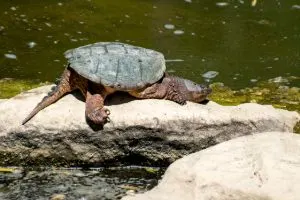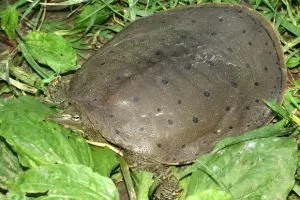Overall, there are 9 species of turtles in Washington State. Only two of these types are native. These are the Western Painted turtle and the Western Pond turtle. Both species originate from the Pacific Northwest.
There are also three species of turtle that have been introduced to areas of Washington State, usually as a result of captive specimens being unsafely released into the wild. These intruders are Red-eared Sliders, Common Snapping turtles, and Spiny Softshells.
The coast of Washington is also visited by four species of sea turtles, many of which nest in Pacific islands such as New Guinea. These are the Green sea turtle, Leatherback sea turtle, Loggerhead sea turtle, and the Olive Ridley sea turtle.
Here is our guide to the species of turtles in Washington state.
Turtles in Washington State
1. Western Painted Turtle

- Experience Level: Beginner
- Family: Emydidae
- Scientific Name: Chrysemys Picta Belli
- Other Names: N/A
- Adult Size: Between 4 and 10 inches
- Lifespan: Between 30 and 50 years
- Average Price Range: Between $20 and $50
- Recommended Books: Painted Turtle Pet Owners Guide by Ben Team
Western Painted turtles are fairly widespread across Washington State. Western Painted turtles are the largest subspecies of Painted turtle and can be found in most types of freshwater throughout their range.
Western Painted turtles sport a series of bold yellow stripes across their skin and face. They have darker patches on their plastrons than their cousins, with dark to olive green shells.
Painted turtles are an aquatic species, often basking near the water. As omnivores, Painted turtles mainly eat mollusks, frogs, and underwater invertebrates. They need to swallow their food in the water due to their fixed tongues.
2. Western Pond Turtle

- Experience Level: Intermediate to Expert
- Family: Emydidae
- Scientific Name: Actinemys Marmorata
- Other Names: Pacific Pond turtle
- Adult Size: Between 6 and 8 inches
- Lifespan: Between 30 and 50 years
- Average Price Range: Around $500
- Where To Buy: theturtlesource.com
- Recommended Books: Aquatic Turtles – Complete Herp Care by David T. Kirkpatrick)
The focus on conservation efforts in Washington State, Western Pond turtles are an endangered species. Only a few populations remain in the Pacific Northwest, mainly concentrated around the Seattle and Tacoma area as well as southern areas around Clark county.
Western Pond turtles have dark brown to olive shells, with flecked light to cream markings. They have yellow plastrons with dark markings as well as brown spotted skin.
Western Pond turtles are an aquatic species inhabiting lakes and ponds and sometimes brackish waters. They are shy and secretive omnivores, mainly consuming fish, worms, insects, and occasionally plants.
Three non-native species of turtles have also been spotted in areas of Washington State. It is likely that the majority of these intruders originated from former captive turtles that were incorrectly released into the wild.
3. Red-eared Slider

- Experience Level: Beginner
- Family: Emydidae
- Scientific Name: Trachemys Scripta Elegans
- Other Names: Water Slider turtle, Red-eared Terrapin
- Adult Size: Between 6 and 8 inches
- Lifespan: Between 20 and 40 years
- Average Price Range: Between $15 and $50
Red-eared Sliders are one of the most popular species of pet turtle on the market. Unfortunately, this makes them incredibly likely to become an invasive species in areas where they were previously non-native.
Red-eared Sliders prefer warm, slow-moving waters such as rivers and lakes. These semi-aquatic turtles like to bask at the water’s edge, and often stack themselves upon each other. These omnivores eat small fish, aquatic invertebrates, and underwater vegetation.
Red Eared Sliders have olive green shells with yellowish striped markings. Their heads are usually darker, with yellow band markings and red patches just behind their eyes.
4. Common Snapping Turtle

- Experience Level: Intermediate to Expert
- Family: Chelydridae
- Scientific Name: Chelydra Serpentina
- Other Names: Common Snapper, Eastern Snapping turtle, Snapper
- Adult Size: Between 8 and 20 inches
- Lifespan: Between 30 and 50 years
- Average Price Range: Between $20 and $40
- Recommended Books: Snapping Turtle Pet Owners Guide by Ben Team
Common Snapping turtles are a large, aggressive freshwater species that usually prefers larger bodies of water. They have become an invasive species in many areas, often threatening local fish or turtle populations.
Common Snapping turtles are easily identified by their distinctive hooked overbites. They usually have dark brown or green ridged shells. They also have strong claws and long tails bearing saw-toothed spines.
Common Snapping turtles are nocturnal omnivores that mainly eat amphibians, crustaceans and fish. They will sometimes eat small waterbirds if they get close enough. Occasionally they will also eat plants.
5. Spiny Softshell Turtle

- Experience Level: Intermediate to Expert
- Family: Trionychidae
- Scientific Name: Apalone Spinifera
- Other Names:
- Adult Size: 5 to 9 ½ inches for males, 7 to 17 inches for females
- Lifespan: Between 20 and 50 years
- Average Price Range: Between $70 and $280
- Recommended Books: Softshell Turtle Owners Guide by Ben Team
Typically favoring rivers or stream with fast moving currents, Spiny Softshell turtles are quick swimmers. They have been sighted in Lake Washington, despite not being a native species.
Spiny Softshells have a leathery rough shell shaped like a pancake. Their shells feel a bit like sandpaper due to the spines on the top of their soft carapace. Long, tapered beaks allow them to breathe while buried in the sand.
Spiny Softshells are carnivores that use their long necks to lash out and catch their prey. They will feed on any crustaceans, insects, and mollusks that swim past their hiding place.
Four varieties of sea turtles can also sometimes be spotted foraging off the coasts of Washington State. All four species are endangered, but may nest in the nearby islands such as Western New Guinea in the Pacific.
While sea turtles cannot be kept as captive pets, we’ll give you a rundown of these species in case you spot them from the shoreline.
6. Green Sea Turtle

- Family: Cheloniidae
- Scientific Name: Chelonia Mydas
- Other Names:
- Adult Size: Between 3 and 4 feet
- Weight: Between 300 and 400 lbs
- Lifespan: Between 80 and 100 years
- Conservation Status: Endangered
- Habitat: Bays and shores along coastlines and open ocean waters, seen during summer months
- Clutch Size: Around 110 to 115 eggs, with 2 to 5 clutches per breeding season
- Food: Mostly herbivores, eating algae, sea grasses and seaweed
- Appearance: Smooth green to brown shells shaped like hearts, edged in yellow. Cream colored scaly skin with shades of green
Check out our Green Sea turtles page for more information.
7. Leatherback Turtle

- Family: Dermochelyidea
- Scientific Name: Dermochelys Coriacea
- Other Names:
- Adult Size: Between 6 and 7 feet
- Weight: Between 1200 and 1450 lbs
- Lifespan: Around 30 years
- Conservation Status: Vulnerable
- Habitat: Warm waters, mainly shallow, calm bays or lagoons. Nests common on sandy beaches.
- Clutch Size: Between 100 and 110 eggs
- Food: Jellyfish is the staple of their diet, but they will also eat other sea creatures
- Appearance: Their large carapaces are soft, unique among sea turtles, with prominent ridges all the way down. Colors vary between black and a dark gray.
Head to our Leatherback sea turtle page for more information.
8. Loggerhead Sea Turtle

- Family: Cheloniidae
- Scientific Name: Caretta Caretta
- Other Names:
- Adult Size: Between 30 and 45 inches
- Weight: Approximately 155 pounds
- Lifespan: Between 70 and 80 years
- Conservation Status: Endangered
- Habitat: Coastal regions, mainly shallow bays. Prefer sub-tropical waters. Sandy ocean beaches for nesting
- Clutch Size: Between 100 and 125 eggs, 4 to 5 clutches per breeding season
- Food: Carnivorous, mainly eating shellfish, mollusks, and crustaceans
- Appearance: Largest hard-shelled turtles with a reddish-brown carapace and large heads. Undersides are cream to yellowish. Long powerful flippers
Visit our Loggerhead sea turtle page for more information.
9. Olive Ridley Sea Turtle

- Family: Cheloniidae
- Scientific Name: Lepidochelys Olivacea
- Other Names: Pacific Ridley sea turtle
- Adult Size: Between 24 and 28 inches
- Weight: Between 75 and 110 lbs
- Lifespan: Around 30 years
- Conservation Status: Vulnerable
- Habitat: Warm tropical seas, shallow coastal waters, mass nesting on sandy beaches
- Clutch Size: Between 75 and 125 eggs
- Food: Crustaceans, shellfish
- Appearance: Triangle-shaped heads. Olive green heart-shaped shells. Green to cream plastrons and undersides.
For more information, visit our Olive Ridley sea turtle page.
Conclusion
In this list we have looked at 9 turtle species that can be found in Washington State. Only two of these species, the Western Painted and Western Pond turtles, are native to the Pacific Northwest.
Three species have been introduced and may be considered invasive. They often appear as a result of pet specimens being unsafely released into the wild. This non-native turtles are the Red-eared Slider, Common Snapping turtle, and the Spiny Softshell.
We also looked at four sea turtle species that can sometimes be spotted off the coasts of Washington. These animals are often foraging for food, and may nest in Pacific Islands nearby. These endangered species are the Green Sea turtle, Leatherback and Loggerhead sea turtles, and the Olive Ridley sea turtle.
Did you enjoy our list of the turtles in Washington State? Feel free to comment below, especially if you’re considering finding some of these species as pets!
Other nearby states

gary wagner
Monday 16th of August 2021
Good grief that one photo is NOT a leatherback turtle!!!